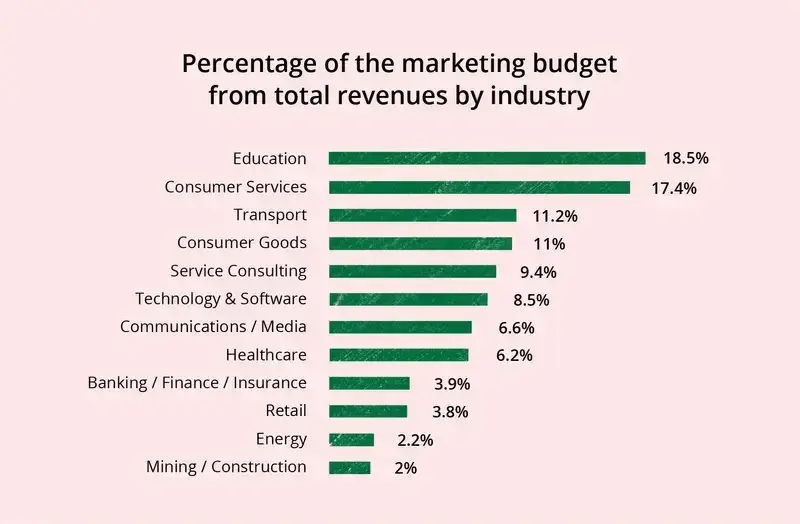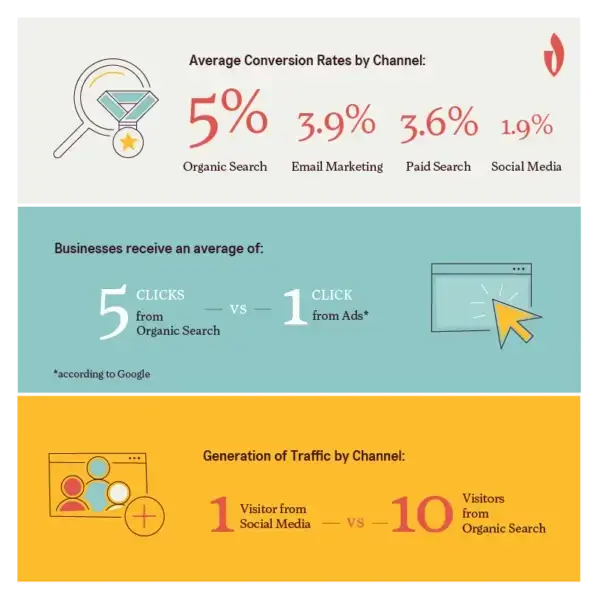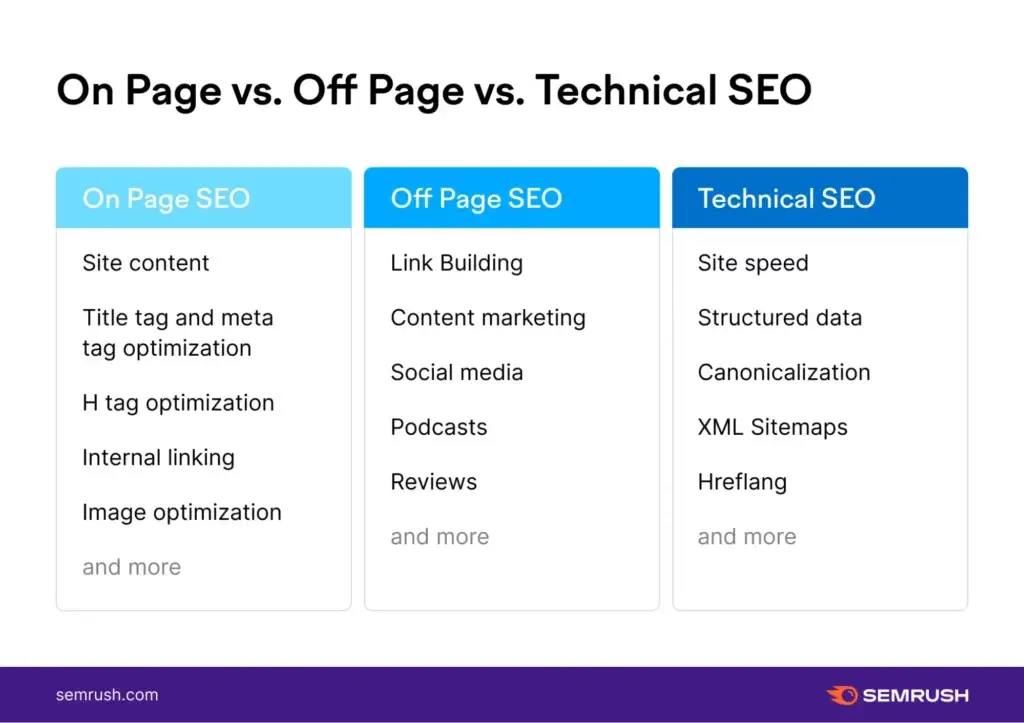Dentists are trained as clinicians, not marketers, yet many dentists take a hands-on approach to their marketing.
Not necessarily a bad thing.
But, there is a problem — lack of knowledge can make marketing difficult and sometimes result in disaster. This is especially true important when you’re dealing with tight marketing budgets.
Most dentists know they need to promote their clinic to get new patients. But whether they own a dental practice or run one as a principal dentist, reliably figuring out the marketing spend can be challenging.
Ideally, the average startup marketing budget should be 11.2% of overall revenue. However, the exact percentage can differ depending on your clinic’s appetite for growth.
Healthcare organisations generally spend 2% – 12% of their gross revenue on marketing, which is consistent with the overall healthcare industry trends.

How much do dentists spend on dental marketing? The truth is every dental practice is unique.
Your spending will ultimately depend on your current growth trajectory and your appetite for higher revenue ceilings to grow your practice.
But understanding the key marketing metrics that move the money needle for your business will give you clarity on what you need to do next.
For instance, you could develop a cost-effective strategy by aligning your marketing KPIs with upcoming campaigns.
The true way to unlock profitable growth from marketing is by being strategic — not trying random marketing as soon as they pop into your head (which is what many new business owners do).
How metrics will help you to choose your budget
To ensure your dental marketing budget is on the right track, you should focus on metrics specific to your dentistry.
Here are five bums-in-seats metrics you need to monitor when marketing your dental practice.
1. Patient Acquisition Cost (PAC, aka “CAC”)
Patient acquisition cost (PAC) can help track the progress of your marketing tactics and is a core part of your success online.
You can also refer to this as Customer Acquisition Cost, which, in simpler terms, just means the cost of getting a new client after marketing expenses.
These expenses could include:
- SEO management costs
- Ad management fees
- Ad platform fees (ad spend)
- Hiring writers to write blog posts
- Website hosting and maintenance
- Booking engine subscriptions
- Tertiary marketing expenses
PAC = Total Marketing/New Patients
So, you guessed it — by dividing your total marketing cost by the number of new patients, it will tell you how much it costs to acquire a new dental patient.
For example, consider a fictional dental practice called BrightSmile Dental, whose PAC is $200. If the clinic wanted to BUY five new clients, they’d have to spend approximately $1000.
Best part?
Once you have a patient through the door, they will likely stick around for years to come. So you’ve not only profited from the initial booking, but you’ll likely continue to reap the rewards for years to come.
There’s a term for this: LTV (or lifetime value — we’ll explore this properly in the next section). If they spent $170 in the first booking, perhaps $200 PAC wasn’t that profitable.
But there’s a high chance they’ll come back and plenty of room for upsells. Most clinics can turn that $170 into a few thousand dollars.
So now, the $200 PAC is only a poultry investment compared to the $2000+ LTV each client could bring to your dental clinic.
Tracking PAC over time lets you gauge the success of your marketing efforts and help you make informed decisions on which campaigns are worth pursuing.
But it’s important to note that PAC is just one piece of a larger puzzle — you also need to track things like patient churn and retention.

2. Patient Lifetime Value (PLTV)
As I briefly explained in the previous section, this PLTV (Patient Lifetime Value) calculates the average amount of revenue your patients will likely spend throughout their interaction with your practice.
To determine PLTV, first, calculate the average value of a patient with the average purchase value and multiply that figure by the average purchase frequency rate.
Average Patient Value = Average Purchase Value X Purchase Frequency Rate
For example, most of your patients may spend $800 every 12 months with you.
Once you figure out that ballpark number, you should determine the average lifespan of a patient and multiply that by the average patient value to arrive at the final Patient Lifetime Value (PLTV).
PLTV= Average Patient Value X Patient Lifespan
For example, they may spend $800 yearly and stick around for 12 years. So the LTV would be $9,600 — the total value they bring to your clinic’s revenue.
PLTV can help you decide which marketing campaigns are worth pursuing and can help your reception team strategically provide upsells or cross-sells that improve your LTV.
For instance, patients who have recently received a checkup and clean may respond positively (and make a purchase) to a follow-up email highlighting Invisalign benefits, with the option to book it through your dental website as a CTA.
3. Patient Churn Rate
Patient Retention Rate is to a dental practice what churn rate is to any regular business selling online.
Acquiring a patient is hard. Keeping them around for longer can be harder.
This metric is a powerful indication of overall patient satisfaction and the quality of your services.
It can help provide insights into how you can optimise your reception experience and marketing efforts to align patient expectations.
You can’t ignore churn rates, but it’s more endgame for mature and established practices. If you haven’t established your PAC (by running ads), I would start there first.

How SEO impacts your budget
Did you know that 68% of people begin their research by using a search engine like Google?
If I had a dollar for every time a dental client discovers (to their horror) that Google isn’t indexing a major chunk of their pages… well, you know the rest.
Regularly checking your SEO is just as important as dental checkups are for your patients. But most practices end up ignoring their SEO because they think it’s a one-off fix.
The truth is search engine optimisation is a zero-sum game. Those who work on it constantly usually reap the rewards of free traffic on search engines.
Here are two SEO tasks you can’t afford to ignore — which also help you understand what budget you need to allocate to the overall amount you spend on marketing.
On-page SEO = your website
This just means anything on your website that could be optimised for SEO. The typical things are (prepare for some heavy jargon):
- Meta titles
- Meta descriptions
- Schema markup
- Slug optimisation
- Keyword insertion
- Over-optimisation
- NLP keywords
- Optimising word counts
In all seriousness, you’ll likely never want to learn what these mean. But they’re very important for making your website eligible to be found on search engines.
‘Eligible’ is the keyword there because it doesn’t guarantee that your website will show up for competitive keywords (that’s where Off-Page SEO comes in, which we’ll discuss below).
A detailed technical SEO audit can reveal the on-page SEO optimisations that your dental business needs to make.
The other on-page component that’s vital to your online success is content.
Google will only index your website for certain keywords as long as you’ve got those keywords mentioned many times on your website (within reason).
For example, if you have a dedicated sales page for ‘Invisalign Treatments Sydney’, you’ll likely be indexed for that keyword and any related keywords.
But if you were to inject random keywords on your home page, it’s unlikely that you’ll rank for any of them — because you haven’t covered those topics in detail on other pages.
Make sense?
The same is true for blog articles. If you cover in-depth, helpful articles on Invisalign, chances are you’ll not only rank for that keyword but also for a bunch of related keywords.
This can take time to do, but it’s incredibly worth it because these pages can act as a boon for your sales teams.
Finding someone to do this for you is a process of trial and error (e.g. finding the right dental marketing agency to help you get it right the first time).
In any case, in-depth blog articles can cost you north of $400, depending on the writer and the word count. I advise that clinics try to commit to one minimum per week.

Off-page SEO = other websites
This is simpler than many people think.
If On-Page SEO is only referring to YOUR website, then Off-Page SEO concerns other people’s websites.
In a nutshell, the goal is to get other websites to point to yours (aka. backlinks). The trick is to make sure they’re quality websites.
As you can imagine, this takes a lot of time. But the good news is that not all of your web pages need the same number of backlinks. And there are many ways to get backlinks.
I cover some great strategies for building backlinks in another post. The main ones you need to focus on are:
- Strategy #1: Guest posting on other people’s blogs
- Strategy #2: Broken backlinking — helping people fix their broken links
- Strategy #3: Creating resource pages — inspiring people to share your content
Now, in terms of pricing, every dental SEO agency is different. Some charge per link (like $400), while others charge per month packages.
And if you want to handle this yourself, you may get lucky finding an SEO freelancer. But in my experience, the lower you pay, the worse your results will be.
Take it from me: I’ve hired the cheapest and the most expensive agencies (that charge $12k/month).
Before you dive into an investment like this, it’s good to get an SEO consultation first.
Make room for online ads
As you know, so many dentists are capitalising on PPC. And it’s no surprise that healthcare digital ad spending will surpass $15 billion by the end of this year.
But how do you know whether a Google Ad is performing well? Here are a few key metrics to consider for measuring its success.
Click-through rate (CTR)
CTR measures how often people who see your advertisement end up clicking on it. It’s an important indicator of how well your ads are performing and can help you determine if changes need to be made to increase engagement with your audience.
You calculate CTR by dividing clicks by impressions and multiplying by 100. A low CTR could indicate that your ad is not engaging or relevant to the target audience.
Cost-per-click (CPC):
CPC represents the total cost a dentist will pay for each click received from their ad. The average CPC for dentists is around $6.49.
Cost per acquisition (CPA):
CPA will determine how much it costs for each new customer you acquire through your advertisements on Google Ads. It’s slightly different from PAC because it’s strictly referring to the cost per acquisition by each platform (e.g. Google Ads).
Conversion rate (CVR):
CVR measures the rate at which website visitors who click on your ad turn into customers. The higher the CVR, the more effective your ad campaign is in turning clicks into customers and generating a return on investment.
Paid advertising metrics provide valuable insights into your campaigns, helping identify the best and worst performers.
You may find your highest-converting ads are more expensive, but they’re generally worth it because your PLTV is usually high.
With this information, you can make data-driven decisions to improve your campaigns by regularly adjusting your ad copy, targeting, and bidding strategies.
See why Google Ads is a viable platform for dentists.

Not all metrics are created equal
While tracking metrics is important, avoid doing it simply for the sake of it. Instead, choose metrics that are relevant to your specific goals.
If you’re trying to expand to more clinics, you need to work out how many new patients each can handle and work towards increasing your bookings (and decreasing no-shows).
And for example, if your goal is to increase website traffic, you may track metrics such as organic search traffic value or traffic volume.
But, if your goal is to increase conversions, it’s best to track metrics like conversion rates, bounce rates, and patient acquisition cost (PAC).
Are you marketing like it’s the 90s?
It surprises me how many dentists are still marketing like it’s the 90s. But the truth is, today’s dental patients are online — using Google to search for the best dentist nearby.
You have to be visible online if you want new patients to find and choose you to solve their dental problems.
Being on the second page on Google won’t cut it.
You either pay for your dental office to show up on Google Ads or invest in SEO to rank organically on the search results page (preferably in the top 3 listings).
Because if you’re not doing this, you’re 100% invisible to your prospective patients.
Now I know you didn’t study SEO or online advertising in dental school, much less everything that goes into being found online.
So if you’re just getting started and want to test the waters, hiring an in-house marketing department may not be realistic. That’s where a dental marketing consultant comes in.
They’ll be able to come up with strategies that fit within your budget and help you save money. Plus, they’ll have the expertise and experience to help you find new patients in ways that you hadn’t even thought of.
So I highly recommend getting a consultation before committing to hefty monthly fees from dental marketing agencies.

